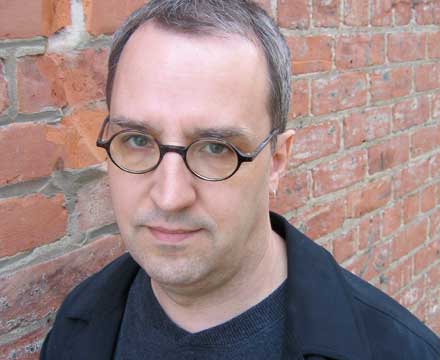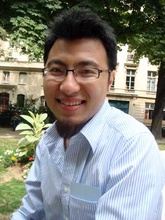
Concert XI
The CNM Ensemble
featuring works by
guest composer Michael Fiday (CCM)
Sunday, February 15, 2015, 7:30pm
Riverside Recital Hall (map)
|| download program ||
Program
| same rivers different (1999) for percussion solo |
Michael FIDAY | |
| Andrew Thierauf, percussion | ||
| Nine Haiku (2005) for flute and piano |
||
| Emily Duncan, flute Korak Lertpubulchai, piano |
||
| Hands On! (1993) for percussion quartet |
||
| Andrew Thierauf, Andrew Veit, Ben Yancey and Wannapha Yannavut, percussion |
||
— Intermission — |
||
| …entrapercevoir… (2013, rec. 2014) for five players |
Wei-Chieh LIN | |
| Emily Duncan, alto flute Thiago Ancelmo de Souza, bass clarinet Bethany Wheeler, harp Andrew Gentzsch, violin Matthew Laughlin, violoncello David Gompper, conductor |
||
| Kreuzspiel (1951) | Karlheinz STOCKHAUSEN | |
| Elliot Czaplewski, oboe Christine Burke, bass clarinet Korak Lertpubulchai, piano Andrew Thierauf, Wannapha Yannavut and Ben Yancey, percussion David Gompper, conductor |
Notes
Michael FIDAY
same rivers different
“Upon those that step into the same rivers different and different waters flow…
They scatter and…gather…come together and flow away…approach and depart.”
— Heraclitus, fragments 12 and 91
Water music, essentially. Some of the music is wet, liquid – some dry as a stone. The pulse like a river – straight, steady, but with abrupt twists, turns. You hear the same music 3 times (but never the same – can’t step in the same stream twice…) followed by an extended afterthought. Originally composed for Arnold Marinissen.
Nine Haiku
are a set of varied musical reflections on texts by Basho. Haiku pose a paradox in terms of scope, their concise forms revealing an entire world within. In keeping with this, some of the reflections are as long as 3 minutes, others barely 30 seconds. I chose the texts, then arranged them in a specific order based on subject (birds, moon, bells), framing them by two outer texts suggesting the beginning and end of a life journey. The first setting does make use of an actual rice planting song (Ta-ue-uta), which recurs from time to time. The last haiku is significant in that it is Basho’s “death poem” – the last haiku he ever wrote. 9 Haiku was originally composed for Eleonore Pameijier and Marcel Worms as part of their ‘6 Continents Project’.
| 1 The beginning of art – a rice-planting song in the backcountry. |
4 As the sound fades, the scent of the flowers comes up – the evening bell. |
7 Clouds come from time to time – and bring to men a chance to rest from looking at the moon. |
| 2 Midfield, attached to nothing, the skylark singing. |
5 Lightning – and in the dark the screech of a night heron. |
8 My eyes following until the bird was lost at sea found a small island. |
| 3 Harvest moon – walking around the pond all night long. |
6 Where’s the moon? As the temple bell is – sunk in the sea. |
9 Sick on a journey, my dreams wander the withered fields. |
Matsuo Basho, Translations: Robert Hass
Hands On!
was originally composed in 1993 for the Dutch percussion ensemble Slagwerkgroep Den Haag, who premiered it in a series of “stokkenthuis” concerts in which the players were forbidden to use drum sticks. All 4 players play the same instruments: congas, bongos, tambourine, hi-hat cymbal – all instruments usually played with either hands or feet. In addition, two of the players share a vibraphone, which is also played by the hands instead of with the customary mallets. The vibraphone functions entirely as a ‘resonance’ instrument, it’s occasional entrances always masked by sharper, louder playing on other instruments – like momentary shades of blue peeking out behind a backdrop of darker, more aggressive lines. As the work unfolds the vibraphone also reveals a thin strand of a chord progression – all in the context of what is basically a rhythm-based music. Certain aspects of Hands On! were inspired by surface features of both Indian and West African drumming. The work was composed under the auspices of a Fulbright grant, and is dedicated to Louis Andriessen.
Michael Fiday’s music has been commissioned and performed extensively throughout the United States, Europe and elsewhere by a diverse range of performers such as Atlanta Symphony, American Composers Orchestra, Oakland East Bay Symphony, Percussion Ensemble of The Hague, pianists James Tocco and Marc-Andre Hamelin, and electric guitarist Seth Josel. His principal teachers in composition have included Richard Toensing at University of Colorado, George Crumb at University of Pennsylvania, and Louis Andriessen, with whom he studied in Amsterdam under the auspices of a Fulbright Grant. Mr. Fiday is the recipient of numerous awards, grants and residencies from, among others, BMI, ASCAP, American Composers Forum, Virginia Center for the Creative Arts, The MacDowell Colony, Yaddo, Headlands Center for the Arts, and the Ohio Arts Council. He is currently Associate Professor of Composition at the College-Conservatory of Music at University of Cincinnati.
Wei-Chieh LIN
…entrapercevoir…
roughly translated as "to catch a glimpse of" or "between perceptions,” is a work that focuses on the methodical transformation of the harp sound and its ramifications, where as the rest of the ensemble serves as an amplifier of such discourse while forging its own path and identity. The initial idea was inspired by Francis Bacon’s paintings concerning ways of disfiguration, saturation, and the violence of expression. The work thus can be heard as glimpsing a painting through layers of translucent screens. As the observer slowly approaches, more layers are unveiled. Yet the original accustomed image becomes more and more distorted to the point of being unrecognizable, as the observer is overwhelmed by the sensation of the colored surface and is immersed only within the grains and the brush strokes. The original version of this work was written in 2013 for the ECCE ensemble and was premiered at the Etchings Festival in France. I would like to specially thank Ms. Mélanie Genin for her tireless efforts and input during the revision process.

Wei-Chieh Lin was born in Taichung, Taiwan, and his music has been performed by ensembles such as Ensemble Intercontemporain, Orchestre Philharmonique de Radio France, National Taiwan Symphony Orchestra, Taipei Sinfonietta & Philharmonic Orchestra, Le Nouvel Ensemble Moderne, Insomnio Ensemble, Alarm Will Sound, Ensemble Phoenix Basel, ECCE Ensemble, Meitar Ensemble, dissonART ensemble, Vertixe Sonora Ensemble, Villiers Quartet, Xasax, Makrokosmos, members of Klangforum Wien, The New Juilliard Ensemble, The Juilliard Orchestra, Formosa Quartet, Cadillac Moon Ensemble, Boston New Music Initiative, Boston Microtonal Society, DZ4 Wind Quartet, members of eighth blackbird, the Hudson Symphony Orchestra, the New Asia Chamber Music Society, and the New York Classical Players Ensemble.
Mr. Lin’s compositions have received awards including the Honorable Mention of the Gaudeamus Muziek Prize of 2011, First Prize of the Sir Ernest MacMillan Award from SOCAN, First Prize of the Pierre Mercure Award from SOCAN, finalist for the 2012 International Composer Pyramid Competition, finalist for the 2014 "Franco Donatoni" International Meeting for Young Composers Composition Competition, two ASCAP Morton Gould Young Composer Awards, selection for the 2014 Taipei International New Music Festival, First Prizes of the 2009 and 2010 National Symphony Orchestra of Taiwan Composition Competitions, and the Third Prize of the 2012 National Taiwan Symphony Orchestra Large Ensemble Composition Competition.
Mr. Lin has participated in music festivals including Aspen, The Wellesley Composers Conference, MusicX Festival, Académie musicale de Villecroze, Domain Forget, Asian Composers League Music Festival, active participant in the Manifeste@Ircam, Voix Nouvelles Royaumont, Etchings Festival, Mizzou International Festival, Composers Encounters 2, Sonutopias Campusculturae Festival, Darmstadt Summer Course, Ensemble Linea Academy, and the Gaudeamus Muziekweek, as well as residencies at Paul Sacher Stiftung, Cité International des Arts, Yellow Barn, the MacDowell Colony, and the Banff Center.
Mr. Lin completed his MM and DMA in composition with scholarship at The Juilliard School under the guidance of Milton Babbitt. Currently he serves as the Co-Artistic Director and pianist of the ECCE Ensemble in New York.
Karlheinz STOCKHAUSEN
Kreuzspiel
Stockhausen was 23 years old when he composed this piece, scoring it for oboe, bass clarinet, piano and three percussionists. He conducted its premiere performance (Darmstadt, 1952), which ended in a scandal. The structure of the piece, consisting of three “stages,” the processes set in motion (clearly and precisely indicated in Stockhausen’s introduction) were evidently too new, too revolutionary. Now, 60 years later, Kreuzspiel is played the world over, from Tokyo to Sao Paulo to Lucerne, as a standard piece in the repertoire of modern classics. The work consists of an interplay, a “crossing” or “intersecting” of “temporal and spatial processes” which are “simultaneously linked” in the third stage.